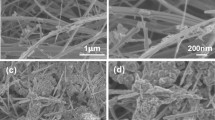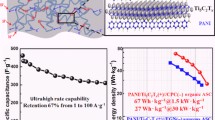Abstract
A binary nanocomposite of polyaniline/tin oxide nanorod array (PANI/SnO2 NRA) was developed as an electrode material for energy storage. SnO2 NRA supported on the substrate of carbon fibers was prepared by the seed-assisted hydrothermal synthesis method. PANI/SnO2 NRA was then obtained by depositing PANI nanowires onto SnO2 NRA through an electro-polymerization process. SnO2 NRA presents quadrangular prism shape with a side length of 50~60 nm. PANI nanolayer is loaded into the interspace of the neighboring SnO2 nanorods to form the core-shell-structured PANI/SnO2 NRA. Additional PANI nanowires with a diameter of 100~150 nm are formed on the top surface of PANI/SnO2 NRA. Well-designed PANI/SnO2 NRA benefited a directional electron transfer along with highly ordered SnO2 nanorods during an electrochemical reaction process. The interface layer between SnO2 nanorods and PANI could act as the buffer space to restrain the volumetric change of PANI during the cycling charge-discharge process. Considering electroactive PANI, PANI/SnO2 NRA exhibited higher specific capacitance of 367.5 F g−1 at 0.5 A g−1 than that of 232.4 F g−1 for bare PANI film. The capacitance retention ratio was enhanced from 60.4% for PANI film to 88.3% for PANI/SnO2 NRA after 2000 cycles even at a high current density of 5 A g−1. All-solid-state PANI/SnO2 supercapacitor was also constructed using symmetric PANI/SnO2 NRA electrodes and sulfuric acid-polyvinyl alcohol gel electrode, presenting the specific capacitance of 44.9 F g−1, the energy density of 20.2 Wh Kg−1, and the output voltage of 1.8 V at 0.2 A g−1 when both PANI and SnO2 were considered as electroactive materials. PANI/SnO2 NRA with high capacitance performance presents the promising supercapacitor applications for the electrochemical energy storage.










Similar content being viewed by others
References
Wang G, Zhang L, Zhang J (2012) A review of electrode materials for electrochemical supercapacitors. Chem Soc Rev 41:797–828
Deshmukh PR, Shinde NM, Patil SV, Bulakhe RN, Lokhande CD (2013) Supercapacitive behavior of polyaniline thin films deposited on fluorine doped tin oxide (FTO) substrates by microwave-assisted chemical route. Chem Eng J 223:572–577
Xie Y, Wang D (2016) Supercapacitance performance of polypyrrole/titanium nitride/polyaniline coaxial nanotube hybrid. J Alloys Compd 665:323–332
Wang K, Wu H, Meng Y, Wei Z (2014) Conducting polymer nanowire arrays for high performance supercapacitors. Small 10:14–31. doi:10.1007/s10008-017-3525-3
Xie Y, Xia C, Du H, Wang W (2015) Enhanced electrochemical performance of polyaniline/carbon/titanium nitride nanowire array for flexible supercapacitor. J Power Sources 286:561–570
Xie Y, Wang D, Ji J (2016) Preparation and supercapacitance performance of free-standing polypyrrole/polyaniline coaxial nanoarray. Energy Technol 4:714–721
Mao L, Zhang K, On Chan HS, Wu J (2012) Surfactant-stabilized graphene/polyaniline nanofiber composites for high performance supercapacitor electrode. J Mater Chem 22:80–85
Nguyen VH, Lamiel C, Kharismadewi D, Tran VC, Shim J-J (2015) Covalently bonded reduced graphene oxide/polyaniline composite for electrochemical sensors and capacitors. J Electroanal Chem 758:148–155
Zhao Z, Xie Y (2017) Enhanced electrochemical performance of carbon quantum dots-polyaniline hybrid. J Power Sources 337:54–64
Lu L, Xie Y (2017) Fabrication and supercapacitor behavior of phosphomolybdic acid/polyaniline/titanium nitride core-shell nanowire array. New J Chem 59:1508–1512
Xie Y, Song F (2016) Preparation and capacitance performance of nitrided lithium titanate nanoarrays. Ceram Int 42:9717–9727
Xie Y, Meng Y, Wu M (2016) Visible-light-driven self-cleaning SERS substrate of silver nanoparticles and graphene oxide decorated nitrogen-doped titania nanotube array. Surf Interface Anal 48:334–340
Xie Y (2016) Photoelectrochemical performance of cadmium sulfide quantum dots modified titania nanotube arrays. Thin Solid Films 598:115–125
Xie Y (2017) Overview of supercapacitance performance of graphene supported on porous substrates. Mater Tech. doi:10.1080/10667857.10662016.11242198
Xie Y, Wang W (2016) Bioelectrocatalytic performance of glucose oxidase/nitrogen-doped titania nanotube array enzyme electrode. J Chem Technol Biotechnol 91:1403–1412
Xie Y, Tian F (2017) Capacitive performance of molybdenum nitride/titanium nitride nanotube array for supercapacitor. Mater Sci Eng B 215:64–70
Pedrós J, Boscá A, Martínez J, Ruiz-Gómez S, Pérez L, Barranco V, Calle F (2016) Polyaniline nanofiber sponge filled graphene foam as high gravimetric and volumetric capacitance electrode. J Power Sources 317:35–42
Gao S, Zang P, Dang L, Xu H, Shi F, Liu Z, Lei Z (2016) Extraordinarily high-rate capability of polyaniline nanorod arrays on graphene nanomesh. J Power Sources 304:111–118
Channu VSR, Holze R (2011) Synthesis and characterization of a polyaniline-modified SnO2 nanocomposite. Ionics 18:495–500
Luo Z, Zhu Y, Liu E, Hu T, Li Z, Liu T, Song L (2014) Synthesis of polyaniline/SnO2 nanocomposite and its improved electrochemical performance. Mater Res Bull 60:105–110
Zhu Y, Liu E, Luo Z, Hu T, Liu T, Li Z, Zhao Q (2014) A hydroquinone redox electrolyte for polyaniline/SnO2 supercapacitors. Electrochim Acta 118:106–111
Li X, Chai Y, Zhang H, Wang G, Feng X (2012) Synthesis of polyaniline/tin oxide hybrid and its improved electrochemical capacitance performance. Electrochim Acta 85:9–15
Shen X, Ma L, Gan M, Li Z, Yan J, Xie S, Yin H, Zhang J (2014) Chemical anchoring of aminobenzoate onto the surface of SnO2 nanoparticles for synthesis of polyaniline/SnO2 composite. Synth Met 196:20–26
Janáky C, Rajeshwar K (2015) The role of (photo)electrochemistry in the rational design of hybrid conducting polymer/semiconductor assemblies: From fundamental concepts to practical applications. Prog Polym Sci 43:96–135
Hu Z-A, Xie Y-L, Wang Y-X, Mo L-P, Yang Y-Y, Zhang Z-Y (2009) Polyaniline/SnO2 nanocomposite for supercapacitor applications. Mater Chem Phys 114:990–995
Kim JG, Nam SH, Lee SH, Choi SM, Kim WB (2011) SnO2 nanorod-planted graphite: an effective nanostructure configuration for reversible lithium ion storage. ACS Appl Mater Interfaces 3:828–835
Liu Y, Jiao Y, Zhang Z, Qu F, Umar A, Wu X (2014) Hierarchical SnO2 nanostructures made of intermingled ultrathin nanosheets for environmental remediation, smart gas sensor, and supercapacitor applications. ACS Appl Mater Interfaces 6:2174–2184
Miao F, Shao C, Li X, Lu N, Wang K, Zhang X, Liu Y (2016) Polyaniline-coated electrospun carbon nanofibers with high mass loading and enhanced capacitive performance as freestanding electrodes for flexible solid-state supercapacitors. Energy 95:233–241
Olad A, Gharekhani H (2015) Preparation and electrochemical investigation of the polyaniline/activated carbon nanocomposite for supercapacitor applications. Prog Org Coat 81:19–26
Lee H, Kwac L, An K, Park S, Kim B (2016) Electrochemical behavior of pitch-based activated carbon fibers for electrochemical capacitors. Energy Convers Manag 125:347–352
Xu W, Zhao K, Niu C, Zhang L, Cai Z, Han C, He L, Shen T, Yan M, Qu L, Mai L (2014) Heterogeneous branched core-shell SnO2-PANI nanorod arrays with mechanical integrity and three dimentional electron transport for lithium batteries. Nano Energy 8:196–204
Wang D, Li X, Wang J, Yang J, Geng D, Li R, Cai M, Sham T-K, Sun X (2012) Defect-Rich Crystalline SnO2 Immobilized on Graphene Nanosheets with Enhanced Cycle Performance for Li Ion Batteries. J Phys Chem C 116:22149–22156
Chen F, Liu P, Zhao Q (2012) Well-defined graphene/polyaniline flake composites for high performance supercapacitors. Electrochim Acta 76:62–68
Jin Y, Jia M (2015) Design and synthesis of nanostructured graphene-SnO2-polyaniline ternary composite and their excellent supercapacitor performance. Colloids Surf A Physicochem Eng Asp 464:17–25
Mao L, Li M, Xue J, Wang J (2016) Bendable graphene/conducting polymer hybrid films for freestanding electrodes with high volumetric capacitances. RSC Adv 6:2951–2957
Xie Y, Ji J (2016) Synthesis and capacitance performance of MnO2/RGO double-shelled hollow microsphere. J Mater Res 31:1423–1432
Acknowledgements
The work was supported by National Natural Science Foundation of China (No. 21373047), Graduate Innovation Program of Jiangsu Province (KYLX15_0126), and Project Funded by the Priority Academic Program Development of Jiangsu Higher Education Institutions.
Author information
Authors and Affiliations
Corresponding author
Rights and permissions
About this article
Cite this article
Xie, Y., Zhu, F. Electrochemical capacitance performance of polyaniline/tin oxide nanorod array for supercapacitor. J Solid State Electrochem 21, 1675–1685 (2017). https://doi.org/10.1007/s10008-017-3525-3
Received:
Revised:
Accepted:
Published:
Issue Date:
DOI: https://doi.org/10.1007/s10008-017-3525-3




